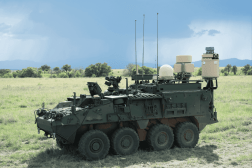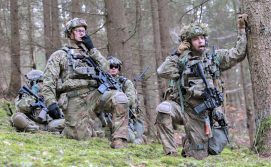Army looking to provide commanders more flexibility with networking and comms gear

As the Army continues to chart a path forward to modernize its network and outfit units with enhanced gear, officials are trying to figure out how to create flexibility for commanders with variations of equipment.
In a paradigm shift across several portfolio areas, the service is getting away from so-called pure fleeting, meaning the entire Army won’t get all the same gear. This is necessitated by differences in unit makeup, missions and environments that forces will be operating in.
Such is true for the network as well.
“I think this is just the next step in our journey to continue to iterate and build a really flexible network for our commanders to have options to employ,” Mark Kitz, program executive officer for command, control, communications and networks, said in an interview. “We learned a lot with the 101st [Airborne Division] and we’re going to learn even more with 25th [Infantry Division]. And then we’re going to continue on that journey as we get to new environments.”
The 2nd Brigade, 101st and 2nd Brigade, 25th are two so-called transforming-in-contact units that the Army has designated. This keystone initiative was set forth by Chief of Staff Gen. Randy George, where the service is using deployments and troop rotations to test new equipment — mainly commercial off-the-shelf gear — that could allow units to be more responsive on a dynamic battlefield. It has initially focused on three main areas where officials say the Army needs to be faster and more adaptable when it comes to delivering equipment to forces, due to how challenging the threat environment is and the cat-and-mouse aspect of countering opponents’ moves: unmanned aerial systems, counter-UAS and electronic warfare. .
The concept saw its first major test with 2nd Brigade, 101st conducting a rotation at the Joint Readiness Training Center at Fort Johnson, Louisiana, over the summer. Now, 2nd Brigade, 25th has picked up that baton and is conducting a rotation at the Joint Pacific Multinational Readiness Center in Hawaii.
“I just got back from the Pacific … What I saw in the 25th ID is that where we left the 101st on the backend of that rotation is where we started with the 25th,” said Maj. Gen Patrick Ellis, director of the network cross-functional team within Army Futures Command, adding that the same exercise controllers at Fort Johnson for the 101st and network personnel have gone to JPMRC to help clean up issues and assist in planning to make this current rotation more smooth for a continuous effort.
“I think we’re going to learn some new stuff out there in the Pacific, much more focused on the mission partner environment and how to incorporate allies, which is something that theaters are always very, very concerned about and how to better do that,” Ellis said. “I think we’re going to learn some really good lessons about that. We’re also going to learn a little bit about, I think, how to employ some of our technologies in the jungle.”
He noted that the TSM waveform for software-defined radios doesn’t work in the jungle like it does in more open environments given the dense foliage.
This is just one example for how the Army needs to think about tailoring certain capabilities to units and theaters and providing commanders with flexibility to employ capabilities the way they need.
“One of the great things is experimenting with these capabilities in the environments they’re going to employ them, so that we can iterate and identify what technologies will work versus what technologies still require investment, modernization or commercial industry engagement,” Kitz said. “I would say in terms of acquisition, we are trying to build programs or a portfolio of programs to give commanders options, so it’s not just one waveform in our tactical radio, that they have a portfolio of waveforms that they can employ … The key acquisition tenet is not building specific programs around specific technologies, but building programs around how we can have a portfolio of technologies to enable this option-based network, so that our network can adapt to the different environments that we’re in.”
The Army’s network team within the program executive office and Futures Command are looking at a variety of capabilities and portfolios from transport — such as proliferated low-Earth orbit satellite communications — to radios and waveforms to command-and-control tools.
As part of that, the team needs to understand how units will employ their capabilities and what they need the network to do for them. More challenging now is that the Army is moving to the division as the unit of action, as opposed to the brigade of the last 20 years during the Global War on Terror. In a potential future conflict against more sophisticated adversaries, units will be spread across much larger distances and need more capabilities resident within the division rather than the brigade.
As the Army began modernizing its network and developing things like the integrated tactical network, made up of commercial off-the-shelf and program-of-record equipment, it started with brigades. Now, it has to think about architecting for division and moving complexity out of brigade units.
“We are truly now engaging on a network with the division as the unit of action. How is the division enabling the down trace units in a holistic network? How do we conduct fires? How do we conduct intel operations? How do I ensure that I’m delivering the right equipment or the right material from a sustainment perspective? How do we envision that entire network from a division perspective is relatively new to the network,” Kitz said.
“That’s what we’re learning from engaging initially with the 101st and now at the 25th and really architecting a larger network that identifies that my down-trace units may not be direct report. They may have a different network component. They may require different network components. Building that flexibility from the division down, I think, is something we’re learning is what we need. And trying to apply these acquisition principles of a portfolio of capabilities is what we’ve been working with Gen. Ellis and the team,” he added.
Ellis noted that it’s all about operational employment of capabilities, using command posts and dispersion as an example.
Across the entire Army, units are trying to get smaller and more mobile to avoid being found and targeted by the enemy. But each unit and each theater is different.
“I talked to battalion commanders and brigade commander in the 25th out there. They are looking to get smaller. In most cases, these guys are going to be dismounted, walking into the jungle, so their command posts are naturally going to get very, very small. The smaller we can enable these guys, the better. Really, again, it’s all about options for employment,” Ellis said. “If they’re fighting the jungle, it’s one thing. If it’s large-scale combat operations in a different theater, they want to aggregate a little bit more.”
Newer technologies allowing more and faster data transport, such as Starlink, provide greater ability for units to disperse and get smaller.
Officials haven’t figured out yet how brigades and divisions will all fight, but they are continuing to communicate with them to make things more reconfigurable.
“The stuff we’ve observed from Ukraine is that if you have to have kind of most Lego blocks for command and control … is I just give you the tools and you can arrange them and rebuild them how you need to, based on the circumstances,” Ellis said. “Because it seemed to me that watching the Ukraine fight is that almost every 90 days, the Russians needed to reconfigure the command control because the Ukrainians have figured out the signature. They need to reconfigure. We’re looking to try and build something that’s inherently reconfigurable, as opposed to building a thing that you got to then destroy and take apart because it’s only good at doing one thing.”






